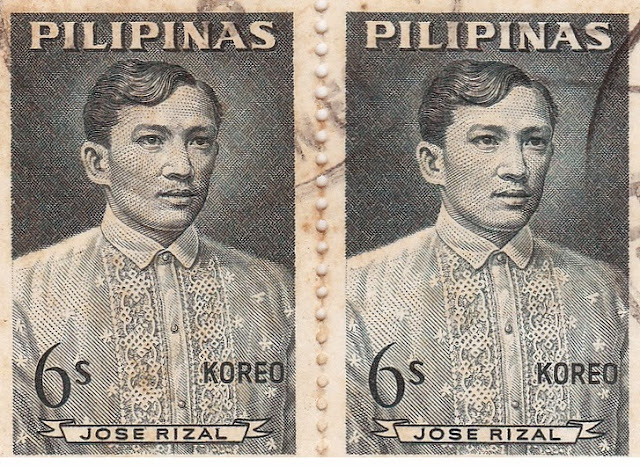Tuesday, 24 December 2013
Jose Rizal: arguably a most famous Quah (Ke) (柯) descendant
I was looking through some of my old stamp albums today. I've got quite a few of them, all dating back to the time when I was just about to enter my teens. The earliest first day cover in my possession for instance, one that was issued by the Malaysian postal authorities, was dated 10 Oct 1964. I wasn't even 10 years old when those stamps came out...
Life in the old days was very simple. No such thing as computers or computer games. No such thing as Internet access. No such thing as mobile telephones, tablets or mobile apps. In fact, if we wanted to have a hobby, the very popular past-times among them were coin collecting, stamp collecting and having pen-pals. I had a pen-pal, but I also plumped for stamp collecting because my father encouraged me to. One of my relatives, an uncle who used to live in a government quarters overlooking the now Penang international airport in Bayan Lepas, was into it too and he used to give me loose stamps. I've no idea where he got them from, but he had a lot of duplicate stamps which he gave away.
That is why I've got to credit Ralph de Vosse for being key in improving my general knowledge of the world around me. The countries of the world, why, I learnt of their very existence through my stamp collection. Nyasaland, Tanganyika, Rhodesia....such exotic names of a few countries in Africa. Ask any teenager today where Malawi, Tanzania and Zanzibar are, and I dare say that they'd be scratching their heads.
Therefore, it was with some nostalgia that I flipped through the pages of my stamp albums this morning. Stamp designs that I had forgotten about quickly came back into my reckon. Then my eyes fell onto several Filipino stamps when I reached that section. A face stared out at me: that of Dr Jose Rizal, acknowledged as the greatest among the national heroes of the Philippines.
I've heard of Jose Rizal before. In 1992 when I visited Manila during the Chess Olympiad, I made it a point to visit the Rizal monument in the city.
The Filipino people are terribly proud of Rizal. His profession was an ophthalmologist but he was also a prolific writer. Through his many works - novels, essays, poems and plays - he galvanised his fellow Filipinos to resist the colonial Spanish authorities and was instrumental in starting a reform movement that grew into a rebellion and subsequently, a revolution. For his role, Rizal was executed by the Spanish Army in Manila on 30 Dec 1896. He was 35 years old.
But there was also one other aspect of Jose Rizal that caught my eye. In the last decade or two, his ancestry had been traced back to China.
Rizal was a fifth-generation patrilineal descendant of a Chinese immigrant entrepreneur who had sailed to the Philippines from Siongque (Zhangcuocun) (张厝村) which was his ancestral village in Chin Kang (modern-day Jinjiang) (晉江), Chuan Chew Hoo (Quanchou) (泉州), Hock Kien Seng (Fukien) in the mid-17th century. The name of his great-great-grandfather was Cue Yi Lam (柯儀南) who then changed his name to Domingo Lamco upon settling down in his new adopted home. The name may have changed but the bloodline remained unchanged.
I'm only mentioning all this because it has now turned out that Jose Rizal and the descendants from his siblings can be considered as part of the wider Quah (柯) diaspora that had left the Hock Kien Seng in China to find a new life in South-East Asia. Interesting, right?
Subscribe to:
Post Comments (Atom)


1 comment:
Hi SS! Glad to know you were able to visit Philippines in 1992. I have been collecting stamps too but have stopped since snail mail began to wane.
I'm sharing to you a bit more of Philippine history through my blog, http://notsoexamined.wordpress.com/2013/12/26/corregidor-more-than-the-ruins/. I hope you take time to visit it as well.
Post a Comment